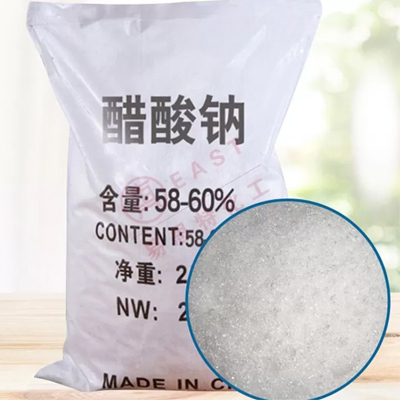What is sodium acetate trihydrate used for?
Sodium acetate trihydrate may not be a household name in the field of chemical compounds, but its versatility and wide range of applications have made it an indispensable player in a variety of industries. This unassuming white crystalline substance has extraordinary properties that have given it a place in food production, pharmaceuticals, and even quirky scientific experiments. In this article, we delve into the fascinating world of sodium acetate trihydrate, exploring its composition, its properties, and its many uses in our daily lives.
Uncovering Sodium Acetate Trihydrate
Before we delve into its applications, let's demystify the composition of sodium acetate trihydrate. Chemically speaking, it is a sodium acetate salt, and the "trihydrate" in its name indicates that it contains three water molecules tightly bound in its crystal structure. This water content is critical to its performance and application.
The Magic of Hot Packs
One of the best known uses of sodium acetate trihydrate is in the production of reusable heat packs. You may have come across these handy devices, often referred to as "heat packs" or "hand warmers", during cold winter days or outdoor activities. How do they work? The magic is in the ability of sodium acetate trihydrate to change from a liquid to a solid when activated.
To activate the pack, you simply bend a small metal disc inside the pack, which releases energy in the form of heat. This energy triggers the crystallisation of the supercooled sodium acetate trihydrate solution inside the pack. As the liquid transforms into a solid, it releases latent heat, providing cosy warmth that can last for hours. What's more, these packs are reusable - to reset them, you simply immerse them in boiling water until the crystals re-dissolve and they're ready to use again.
In the culinary world
Sodium acetate trihydrate also has a place in the culinary world, mainly as a food additive, with an E number of E262. It has several essential functions in food production:
Acid regulator: Sodium acetate helps to control the acidity of a wide range of foods, ensuring that they have a consistent and desirable flavour.
Preservative: It inhibits the growth of bacteria and moulds in certain foods, prolonging their shelf life and ensuring they are safe to eat.
Flavour enhancer: Sodium acetate can enhance the overall flavour of certain dishes, making it a valuable ingredient in the food industry.
Buffering: In the production of some processed foods and snacks, Sodium Acetate Trihydrate helps to maintain a stable pH level, preventing unwanted changes in texture and flavour.
Cheese production: Cheese makers use it to regulate the pH of cheese curds during the production process, helping to achieve the desired texture and flavour.
In the pharmaceutical industry
The pharmaceutical industry has used the unique properties of sodium acetate trihydrate for a variety of purposes:
Buffer: Sodium acetate trihydrate is used in the preparation of buffer solutions, which are essential for various laboratory techniques and pharmaceutical formulations. Buffer solutions help maintain a stable pH level, ensuring the effectiveness and safety of drugs.
Intravenous solutions: It plays a vital role in intravenous (IV) fluids and is used as a pH regulator to maintain the correct acid-base balance. This is essential for medical procedures and patient health during treatment.
Pharmaceutical Manufacturing: Sodium acetate trihydrate is used in the production of certain pharmaceuticals to help control the pH of drug formulations and maintain their stability.
Offbeat Science and Demonstrations
In addition to its more practical applications, sodium acetate trihydrate sparks the imagination of science enthusiasts and educators. It has been the mainstay of many interesting and visually appealing demonstrations:
Hot Ice: The crystallisation process of sodium acetate trihydrate generates heat and is often referred to as "hot ice". This phenomenon can be demonstrated by dissolving the compound in water, subcooling the solution, and then initiating crystallisation by simply tapping the container. This is a fascinating demonstration of an exothermic reaction.
Instant Ice Sculptures: Sodium acetate trihydrate can be used to create instant ice sculptures or ice sculptures, making it a favourite among science educators for classroom experiments.
Industrial Applications
The versatility of sodium acetate trihydrate extends to a variety of industrial processes:
Textile Industry: Used in textile dyeing and printing, it helps to regulate pH in these processes.
Electroplating: In electroplating, where a metallic coating is applied to an object, Sodium Acetate Trihydrate acts as a buffer, helping to maintain the desired pH and ensuring smooth, uniform metal deposition.
Concrete and Construction: The compound is used to formulate concrete mixtures and as a de-icer for road maintenance in cold climates.
Oil and gas drilling: Sodium acetate trihydrate is used in drilling fluids for oil and gas exploration to help control pH and prevent corrosion.
Safety Considerations
While sodium acetate trihydrate is generally safe when used as intended, careful handling is critical. The compound can irritate the skin and eyes, so protective measures should be taken when using it. In addition, ingestion or inhalation of large quantities may cause health problems, so it should be kept out of reach of children and used in a well-ventilated area.
Conclusion
Among the many chemicals and compounds that shape our world, sodium acetate trihydrate stands out as a versatile and valuable player. From providing warmth on cold days to ensuring the safety and efficacy of medications, this unassuming white crystalline substance has a place in many aspects of our lives. Its unique ability to transform from a liquid to a solid by releasing heat has led to innovations in things like heat packs and quirky science experiments. Whether in the culinary arts, pharmaceuticals or industrial processes, sodium acetate trihydrate proves that sometimes the unsung heroes of chemistry have the most significant impact on our daily lives.
265
0
0


Comments
All Comments (0)